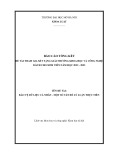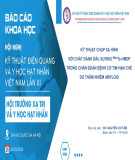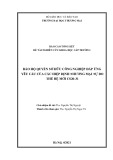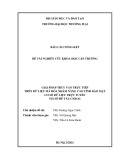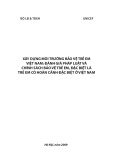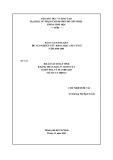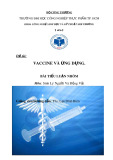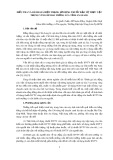
RESEARC H Open Access
High efficient isolation and systematic identification
of human adipose-derived mesenchymal stem cells
Xu-Fang Yang
1,2
,XuHe
1*
, Jian He
1
, Li-Hong Zhang
1
, Xue-Jin Su
1
, Zhi-Yong Dong
1
, Yun-Jian Xu
3
, Yan Li
4
and
Yu-Lin Li
1*
Abstract
Background: Developing efficient methods to isolate and identify human adipose-derived mesenchymal stem cells
(hADSCs) remains to be one of the major challenges in tissue engineering.
Methods: We demonstrate here a method by isolating hADSCs from abdominal subcutaneous adipose tissue
harvested during caesarian section. The hADSCs were isolated from human adipose tissue by collagenase digestion
and adherence to flasks.
Results: The yield reached around 1 × 10
6
hADSCs per gram adipose tissue. The following comprehensive
identification and characterization illustrated pronounced features of mesenchymal stem cells (MSCs). The
fibroblast-like hADSCs exhibited typical ultrastructure details for vigorous cell activities. Karyotype mapping showed
normal human chromosome. With unique immunophenotypes they were positive for CD29, CD44, CD73, CD105
and CD166, but negative for CD31, CD34, CD45 and HLA-DR. The growth curve and cell cycle analysis revealed
high capability for self-renewal and proliferation. Moreover, these cells could be functionally induced into
adipocytes, osteoblasts, and endothelial cells in the presence of appropriate conditioned media.
Conclusion: The data presented here suggest that we have developed high efficient isolation and cultivation
methods with a systematic strategy for identification and characterization of hADSCs. These techniques will be able
to provide safe and stable seeding cells for research and clinical application.
Background
Mesenchymal stem cells have been widely used in
experimental and clinical research because of their
unique biological characteristics and advantages [1-4]. In
a previous study, we have developed standardized tech-
niques for the isolation, culture, and differentiation of
bone marrow-derived mesenchymal stem cells [5-7].
Recent reports have shown that the widely-spreaded
human adipose tissue provides abundant source of
mesenchymal stem cells, which can be easily and safely
harvested as compared with human bone marrow
[8-10]. The adipose tissue from abdominal surgery or
liposuction is usually rich in stem cells which can meet
the needs of cell transplantation and tissue engineering
[11]. Meanwhile, these stem cells have high ability for
proliferation and multilineage differentiation [12,13].
Therefore, human adipose-derived mesenchymal stem
cell (hADSC) is becoming a potential source for stem
cell bank and an ideal source of seeding cells for tissue
engineering. Although some labs have successfully iso-
lated hADSCs from adipose tissues, there is still no any
widely-accepted efficient method for isolating and cul-
turing highly homogenous and undifferentiated hADSCs.
The comprehensive methods for identification and char-
acterization of hADSCs have not been fully established
yet. The aim of current study was to develop high effi-
cient methods to isolate and identify hADSCs.
Methods
Subjects
Human adipose tissue was obtained at caesarian section
from the abdominal subcutaneous tissue of obese
women delivered, in the maternity department at Jilin
University (age range: 23-41 years; mean = 32 years
old). The subjects were healthy without any regular
medication. Informed consent was obtained from the
* Correspondence: hexu@jlu.edu.cn; ylli@jlu.edu.cn
1
Key Laboratory of Pathobiology, Ministry of Education, Norman Bethune
College of Medicine, Jilin University, Changchun, China
Full list of author information is available at the end of the article
Yang et al.Journal of Biomedical Science 2011, 18:59
http://www.jbiomedsci.com/content/18/1/59
© 2011 Yang et al; licensee BioMed Central Ltd. This is an Open Access article distributed under the terms of the Creative Commons
Attribution License (http://creativecommons.org/licenses/by/2.0), which permits unrestricted use, distribution, and reproduction in
any medium, provided the original work is properly cited.





